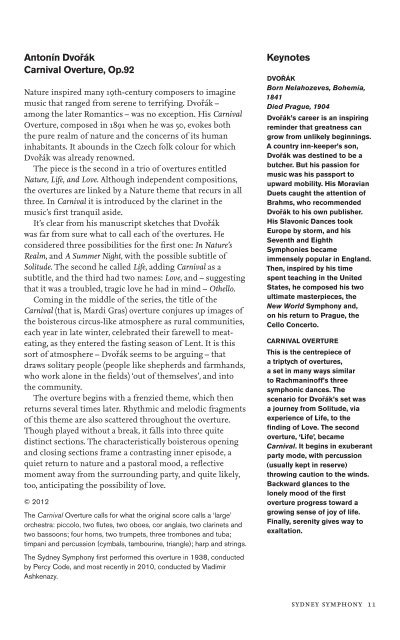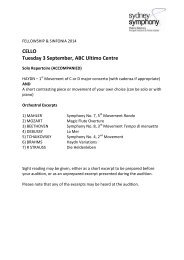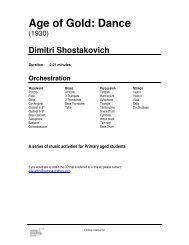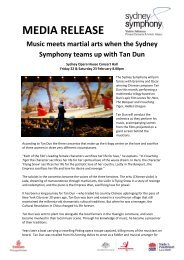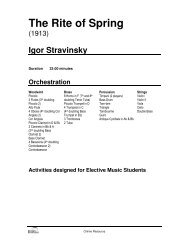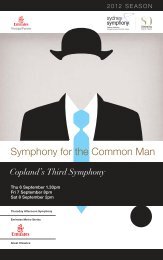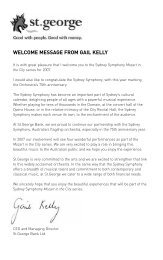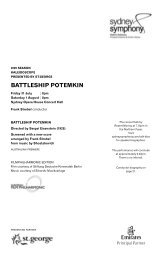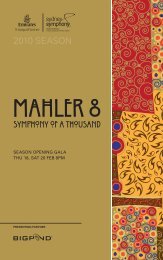Symphonic Dances - Sydney Symphony
Symphonic Dances - Sydney Symphony
Symphonic Dances - Sydney Symphony
You also want an ePaper? Increase the reach of your titles
YUMPU automatically turns print PDFs into web optimized ePapers that Google loves.
Antonín Dvoˇrák<br />
Carnival Overture, Op.92<br />
Nature inspired many 19th-century composers to imagine<br />
music that ranged from serene to terrifying. Dvoˇrák –<br />
among the later Romantics – was no exception. His Carnival<br />
Overture, composed in 1891 when he was 50, evokes both<br />
the pure realm of nature and the concerns of its human<br />
inhabitants. It abounds in the Czech folk colour for which<br />
Dvoˇrák was already renowned.<br />
The piece is the second in a trio of overtures entitled<br />
Nature, Life, and Love. Although independent compositions,<br />
the overtures are linked by a Nature theme that recurs in all<br />
three. In Carnival it is introduced by the clarinet in the<br />
music’s fi rst tranquil aside.<br />
It’s clear from his manuscript sketches that Dvoˇrák<br />
was far from sure what to call each of the overtures. He<br />
considered three possibilities for the fi rst one: In Nature’s<br />
Realm, and A Summer Night, with the possible subtitle of<br />
Solitude. The second he called Life, adding Carnival as a<br />
subtitle, and the third had two names: Love, and – suggesting<br />
that it was a troubled, tragic love he had in mind – Othello.<br />
Coming in the middle of the series, the title of the<br />
Carnival (that is, Mardi Gras) overture conjures up images of<br />
the boisterous circus-like atmosphere as rural communities,<br />
each year in late winter, celebrated their farewell to meateating,<br />
as they entered the fasting season of Lent. It is this<br />
sort of atmosphere – Dvoˇrák seems to be arguing – that<br />
draws solitary people (people like shepherds and farmhands,<br />
who work alone in the fi elds) ‘out of themselves’, and into<br />
the community.<br />
The overture begins with a frenzied theme, which then<br />
returns several times later. Rhythmic and melodic fragments<br />
of this theme are also scattered throughout the overture.<br />
Though played without a break, it falls into three quite<br />
distinct sections. The characteristically boisterous opening<br />
and closing sections frame a contrasting inner episode, a<br />
quiet return to nature and a pastoral mood, a refl ective<br />
moment away from the surrounding party, and quite likely,<br />
too, anticipating the possibility of love.<br />
© 2012<br />
The Carnival Overture calls for what the original score calls a ‘large’<br />
orchestra: piccolo, two flutes, two oboes, cor anglais, two clarinets and<br />
two bassoons; four horns, two trumpets, three trombones and tuba;<br />
timpani and percussion (cymbals, tambourine, triangle); harp and strings.<br />
The <strong>Sydney</strong> <strong>Symphony</strong> first performed this overture in 1938, conducted<br />
by Percy Code, and most recently in 2010, conducted by Vladimir<br />
Ashkenazy.<br />
Keynotes<br />
DVO ˇRÁK<br />
Born Nelahozeves, Bohemia,<br />
1841<br />
Died Prague, 1904<br />
Dvoˇrák’s career is an inspiring<br />
reminder that greatness can<br />
grow from unlikely beginnings.<br />
A country inn-keeper’s son,<br />
Dvoˇrák was destined to be a<br />
butcher. But his passion for<br />
music was his passport to<br />
upward mobility. His Moravian<br />
Duets caught the attention of<br />
Brahms, who recommended<br />
Dvoˇrák to his own publisher.<br />
His Slavonic <strong>Dances</strong> took<br />
Europe by storm, and his<br />
Seventh and Eighth<br />
Symphonies became<br />
immensely popular in England.<br />
Then, inspired by his time<br />
spent teaching in the United<br />
States, he composed his two<br />
ultimate masterpieces, the<br />
New World <strong>Symphony</strong> and,<br />
on his return to Prague, the<br />
Cello Concerto.<br />
CARNIVAL OVERTURE<br />
This is the centrepiece of<br />
a triptych of overtures,<br />
a set in many ways similar<br />
to Rachmaninoff’s three<br />
symphonic dances. The<br />
scenario for Dvoˇrák’s set was<br />
a journey from Solitude, via<br />
experience of Life, to the<br />
finding of Love. The second<br />
overture, ‘Life’, became<br />
Carnival. It begins in exuberant<br />
party mode, with percussion<br />
(usually kept in reserve)<br />
throwing caution to the winds.<br />
Backward glances to the<br />
lonely mood of the first<br />
overture progress toward a<br />
growing sense of joy of life.<br />
Finally, serenity gives way to<br />
exaltation.<br />
sydney symphony 11


